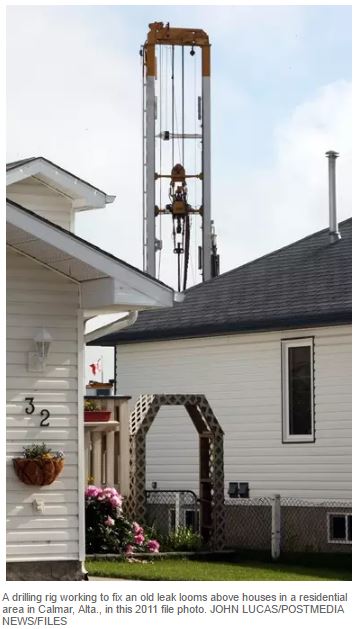Report: Wyoming students, teachers fell ill during gas leak by Education Week, November 30, 2016
CHEYENNE, Wyo. (AP) — Dozens of students and teachers at a school in a small Wyoming town fell ill while breathing gases from a leaky oil well last spring, according to a recent Wyoming Department of Health survey.
The K-12 school in Midwest, population 400, has been closed since May 25 after testing showed benzene levels more than 200 times the safe limit. Carbon dioxide inside the building exceeded by five times the recommended occupational health limit, according to the Centers for Disease Control.
In the weeks leading up to the closure, more than half of the 84 students and 45 staff who completed the state survey reported headaches and stuffy noses. One-third reported coughing. Around one-quarter reported nose, eye and throat irritation.
The symptoms lessened significantly after the Natrona County School District began busing the students and staff to schools in Casper, according to the report released last week.
“Given the levels of those gases were so high in that building, it can be concluded that the illnesses were mostly due to exposure to those gases,” interim State Epidemiologist Clayton Van Houten said Tuesday.
The risk of long-term health effects from the exposure is negligible, he said.
The leaking benzene and carbon dioxide tapered off after Irving, Texas-based petroleum company Fleur de Lis Energy, LLC, re-plugged the problem well in one of the nation’s oldest oil fields. FDL bought the Salt Creek Oil Field from Anadarko Petroleum last year.
This year, 148 students and their teachers in Midwest continue to attend school in classroom space 40 miles away in Casper.
Plans for a ventilation system under the foundation could enable the Midwest school to reopen next school year, district spokesman Kelly Eastes said.
FDL has been working with the district on the system, Eastes added. [Emphasis added]
Harmful Concentrations Of Benzene, CO2 Detected At Midwest School by Stephanie Joyce, September 13, 2016, Wyoming Public Radio
A federal agency says elevated levels of carbon dioxide and benzene at the Midwest School are an “urgent public health hazard.”
Administrators shut down the school at the end of May, after students and staff reported smelling gas-like odors. The Agency for Toxic Substances and Disease Registry says air samples from May 26, two days after the school shut down, contained levels of benzene 200 times what is considered safe and carbon dioxide levels 26 times the recommended limit. Exposure to both gases in high concentrations can cause dizziness and confusion in the short-term and long-term exposure to benzene is linked to cancer.
The school and the town of Midwest are surrounded by the Salt Creek oil field, operated by Fleur de Lis (FDL). [Previously owned by Anadarko, Refer below for more information] While officials aren’t certain what caused the contamination, FDL found a leaking well in the school’s parking lot, which it has since plugged.
[Compare to Imperial Oil’s leaking energy wells in Calmar Alberta:
2014 12 08: Five years, five homes demolished and gas keeps bubbling from the deep (with video) Part 2: Trouble Beneath Our Feet – Trying to plug the leak in Calmar, Alberta
2010 Front Page Edmonton Journal
End Compare to Imperial’s leaking wells in Calmar Alberta, also in a school yard]
A recent air quality sampling showed gas levels had dropped to safe levels. Kelly Weidenbach, director of the Casper-Natrona County Health Department, says while exposure to such high levels of benzene could certainly cause short-term health problems, the risk of cancer is low.
“It is measurable—it’s not zero,” she said. “But it’s pretty close to zero.”
[Childhood Cancer Reality Check:
2015 12 18: “What is the acceptable risk for increased risk for childhood cancer? It’s zero.” ]
Weidenbach says before the school can reopen, the administration needs to develop a mitigation plan and install carbon dioxide monitors. [Why is it the school’s responsibility? Where’s the energy regulator? Too busy taking $1.5 Million from Encana to write reports blaming nature for the company’s leaking pits, aquifer fracs, miserly well casing, migrating gases and all round lousy “Best Practices” contaminating drinking water wells at Pavillion?]
“Once the school can demonstrate that it can maintain healthy indoor air quality, they will also need to develop a response plan,” she said.
A response plan, in case the problem returns. For now, students from Midwest are attending other schools in the Casper area.
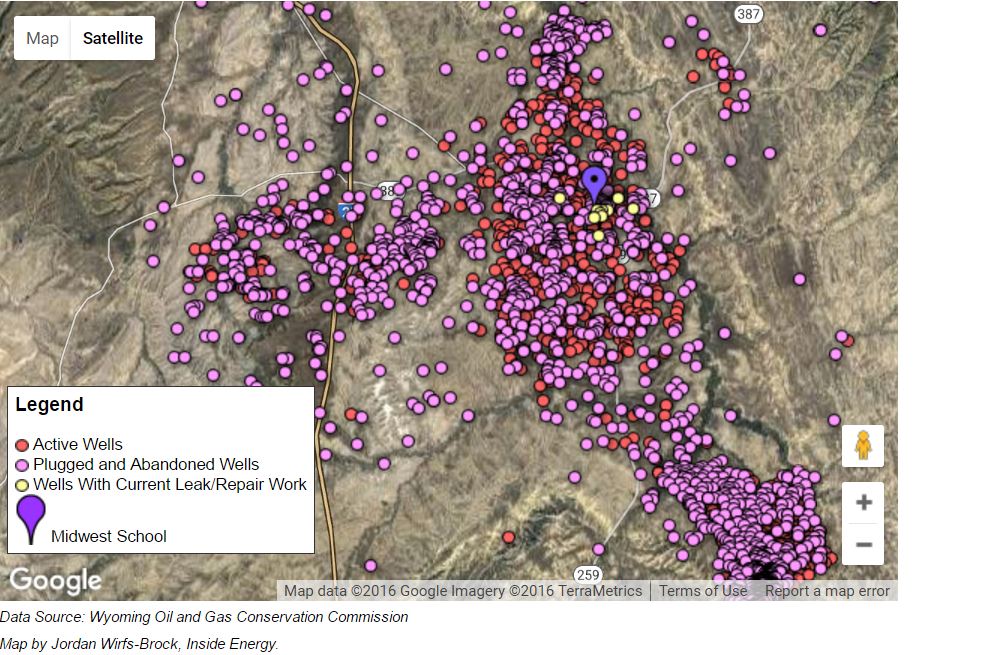 This map shows wells in and around Midwest, Wyoming, based on information in the state oil and gas commission’s database. Zoom out to see the nearly 750 active and former wells within a 1 mile radius of the town. Wells that are being inspected in relationship to the leak near Midwest School are yellow (as of June 10, 2016), wells that are active are red, and wells that are plugged/abandoned are pink. Click on a well to see which company operates it. [Emphasis added]
This map shows wells in and around Midwest, Wyoming, based on information in the state oil and gas commission’s database. Zoom out to see the nearly 750 active and former wells within a 1 mile radius of the town. Wells that are being inspected in relationship to the leak near Midwest School are yellow (as of June 10, 2016), wells that are active are red, and wells that are plugged/abandoned are pink. Click on a well to see which company operates it. [Emphasis added]
[Click on map to go to article to zoom in on the wells]
School District Hosts Meeting Next Week For Midwest School Parents, Staff
by Tom Morton, September 15, 2016, K2 Radio
The Natrona County School District will hold a meeting next week for students, parents, staff and community members concerned about Midwest School, according to a news release today.
District officials will talk about recent developments from the Casper-Natrona County Health Department about the school’s closure in May and the current investigation. The meeting will happen at the Midwest Town Hall, 256 Lewis, at 5:30 p.m. Tuesday, Sept. 20
“We understand the temporary changes faced by students/staff and their families at Midwest have not been easy,” the news release said. “We truly empathize with the Midwest community, and the difficulties faced, during this transitional time.”
… This semester, the school’s students are attending classes at Roosevelt/PIC and Westwood Elementary in Casper
At its meeting Monday, the Natrona County School District’s board of trustees and parents discussed the situation and some findings of a new report from the Casper-Natrona County Health Department.
The school district reported this progress about the investigation:
• NCSD is receiving proposals from environmental/certified industrial hygienist consulting firms.
• The consulting firm will be selected by Oct. 1.
• The firm will review and analyze all data from all entities collected since the gas leak.
• This firm will review plans about the mitigation design proposal from Salt Creek Oil Field owner FDL, and will coordinate with the health department and other state and federal agencies.
• The firm will plan and conduct indoor and outdoor air monitoring sampling including basement, crawlspace and sub floor slab areas, and review lab results.
• Locations will be selected for permanent indoor and outdoor air monitoring equipment for the building.
• A backup system will be developed for continued air monitoring and reporting.
• The consulting firm will develop and coordinate with the health department an evacuation plan and develop a longterm health and safety plan for the building.
Midwest School Remains Closed This Semester; Air Quality Analysis Showed High Levels Of CO2 And Benzene by Tom Morton, September 12, 2016, K2 Radio
Midwest School second-grade student Marco O’Brien on Monday shyly but succinctly described how his school’s travails — shut down in May because of very high levels of carbon dioxide and benzene — have affected him.
“I don’t like to wake up early in the morning and be on the bus,” the 12-year-old told the Natrona County School District board of trustees about having to commute to Casper.
Despite the sleepy inconvenience, the district had to shut down the school May 26.
The Casper-Natrona County Health Department on Monday reported the Agency for Toxic Substances and Disease Registry, a division of the U.S. Centers for Disease Control and Prevention, completed a formal review of the air sampling it conducted on June 16 and 17,
“ATSDR concluded that the air quality events that occurred in Midwest School in May 2016 constituted an urgent health hazard and that school officials and others who determined that the school needed to be evacuated were right in doing so,” the report said.
The most serious findings from testing on May 26 were very high levels of carbon dioxide, areas of the school that were deficient in oxygen, and one classroom that had a level of benzene 200 times more than ATSDR guidelines.
Short-term effects of inhaling benzene include drowsiness, tremors, unconsciousness and death. Long-term exposure can cause anemia, cancer and leukemia, the report said.
[What are the children, their families and other residents breathing in their homes and town?]
Air quality varied from day to day. The air quality on the June testing dates was much better than on May 25, according to the report.
The health department reported the Salt Creek Oil Field owner Fleur de Lis Energy, LLC, has been monitoring the school’s air quality during the summer,
FDL has not found any abnormal CO2 levels since it tested the area on June 6 and 17.
FDL has sealed an old well next to the school. It has conducted a comprehensive evaluation of every well bore drilled within a half-mile of the school, has looked for other sources of gas, and has retained an environmental consulting company to advise it about soil remediation.
[Industry’s Gas Migration Reality Check:
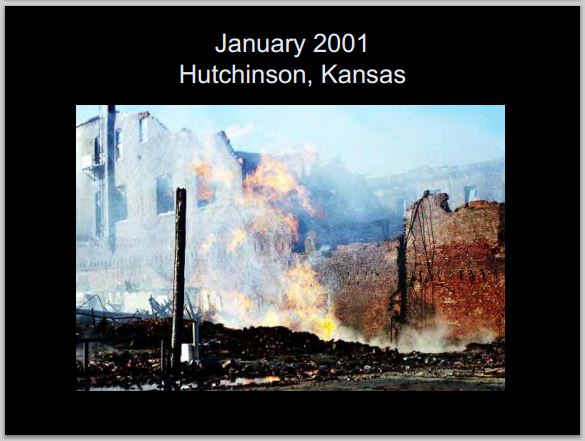
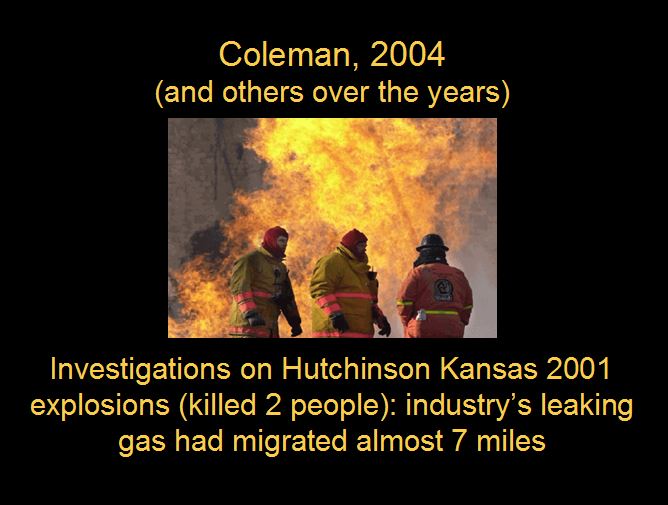
Slides from Ernst presentations
End Industry’s Gas Migration Reality Check]
The health department interviewed 139 staff and students and turned the results of those surveys to epidemiologists at the Wyoming Department of Health. Evaluating those surveys will take several weeks.
Department Director Kelly Weidenbach said it has recommended the school district implement these programs: develop an indoor air quality mitigation and monitoring plans, conduct another round of air quality sampling, place CO2 monitors in the school, and develop a response plan if or when other air quality problems occur.
In June, FDL installed a vapor extraction system in the school, which has been effective in improving the indoor air quality, Weidenbach said.
“The big concern is the benzene that was found in the school,” she said. “The ATSDR did some calculations and found that the increased risk of cancer is very low. It is not zero, but it is very, very low. We are not expecting any increase in cancer in staff and students at the school.”
But the school’s closure will continue to cause problems for Marco O’Brien and dozens of other Midwest School Pre-K through eighth grade students who need to be on the bus by about 6:30 a.m. to ride to Casper and attend classes at Westwood Elementary School.
Likewise, ninth through 12th grade students ride a bus to attend classes at the new Roosevelt/P.I.C. (Pathways Innovation Center) School.
Parents also voiced their frustrations with the closure, such as Justin Marken who wanted to know if the district would allow Midwest School to host its homecoming game on its own field.
Board Chairman Kevin Christopherson said he’ll look into that.
Meanwhile, Christopher said the health department, federal and state agencies must deal with the safety issues.
The school will be closed through this semester, but that doesn’t mean it will reopen after that, Christopherson said.
Nor does it mean, contrary to rumors, the district is considering closing Midwest School permanently, he said.
“We’re not even thinking about it,” Christopherson said. “Right now we are all looking how to get in there and make it a viable school again as soon as possible.” [Emphasis added]
Mysterious Gas Leak In A Town Surrounded By Wells by Stephanie Joyce and Jordan Wirfs-Brock, June 14, 2016, Wyoming Public Radio
The search is continuing for the source of a gas leak that shut down a school in Midwest, Wyoming at the end of May.
Fleur de Lis, the company that operates the neighboring Salt Creek oil field, says it has plugged one leaking well near the school, worked on another six and is continuing to monitor as many as 30 other wells in the area.
The Salt Creek field is the oldest in Wyoming, and an Inside Energy analysis of the state oil and gas database shows there are more than 700 active and abandoned wells in a one-mile radius around the Midwest school.
Many of those wells were drilled decades ago, and those that have been abandoned may or may not be properly plugged. In the past, it was common for companies to abandon wells by filling them with mud or even fence posts.
It’s also possible that not all well locations are known. A 2006 study by the National Energy Technology Laboratory identified several dozen wells in a single square mile of the Salt Creek Field that were not in company databases.
Staff at Midwest School first reported a strange odor on May 25 and initial air quality testing detected high levels of carbon dioxide as well as volatile organic compounds inside the school. Students finished out the school year at the old North Casper Elementary School.
Additional air quality testing is ongoing, to help backtrace the leak. “And also to identify potential human health risks from those gases,” said Kelly Weidenbach, Director of the Casper- Natrona County Health Department.
In the meantime, the company has offered to relocate any families living nearby who would like to leave.
A previous Inside Energy investigation also found that state records for the locations of abandoned wells in Wyoming and surrounding states are not always accurate, and that abandoned wells are frequently unmarked on the surface. In the map below, we have noted known well locations by the latitude and longitude listed in the state well database, but the well locations on the ground may not correspond to state records.
This map shows wells in and around Midwest, Wyoming, based on information in the state oil and gas commission’s database. Zoom out to see the nearly 750 active and former wells within a 1 mile radius of the town. Wells that are being inspected in relationship to the leak near Midwest School are yellow (as of June 10, 2016), wells that are active are red, and wells that are plugged/abandoned are pink. Click on a well to see which company operates it.
The Wyoming Oil and Gas Conservation Commission also provided Inside Energy with a list of 10 wells that Fleur de Lis has worked on or is monitoring. It is unclear how the list relates to the thirty-plus wells Fleur de Lis claims it is monitoring, and the Commission did not respond to repeated requests for clarification. Information about the individual wells can be located on the Wyoming Oil and Gas Conservation Commission website.
The table below shows information provided by the Wyoming Oil and Gas Conservation Commission on the recent work that has been done on nearby wells to investigate the source of the potential leak.
Editor’s Note: The Wyoming Oil and Gas Conservation Commission says their records show approximately 140 wells within a half mile radius of the school and approximately 550 wells within a one mile radius around the school. Our own analysis of the WOGCC data puts the number of wells within a mile of the school at 744.
More Than A Leak; Midwest School Affected By Large Amounts Of CO2, Natural Gas by Tom Morton, May 26, 2016, K2 Radio
The so-called gas leak that shut down Midwest School is an unusual release of gas, oil and carbon dioxide from the ground, a spokesman for the company that owns the Salt Creek oil field said Thursday. [From the ground? Or from the company’s leaking wells?]
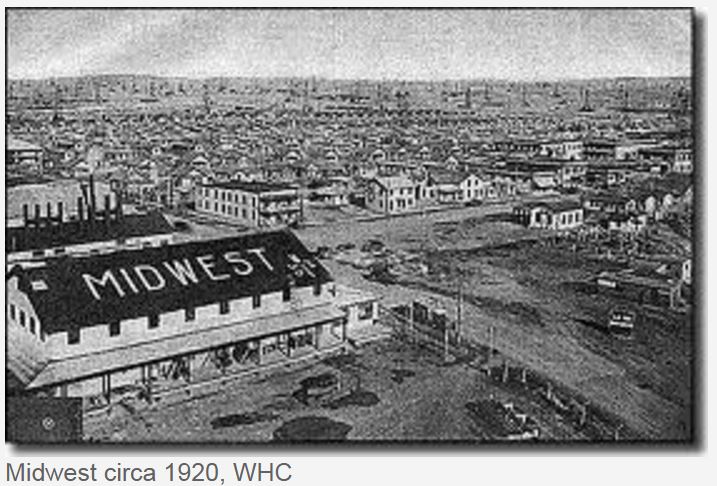
“We currently have an ongoing investigation trying to find out where the odor is coming from,” said Trevor Christensen of the Irving, Texas-based Fleur de Lis Energy, LLC.
The Natrona County School District announced Wednesday evening that a gas leak forced the school to close for Thursday, and then it announced the classes will be held for the rest of the academic year at the former North Casper Elementary School beginning Friday.
It is much more than that, Christensen said.
Those monitoring the situation have detected natural gas; carbon dioxide, which has been used for oil recovery; and trace amounts of methane, he said.
The company has notified the residents of Midwest about the situation, Christensen said.
It also temporarily evacuated houses near the school where some teachers and staff live during the week, he said. “That was done to ensure their safety.”
There is no definitive timeline when students and staff may return to the school, Christensen said.
A spokesman for the Natrona County School District did not return calls seeking comment Thursday.
Besides Fleur de Lis, Christensen said Casper Safety Consultants is monitoring gas levels in and around the school and the Town of Midwest.
The Natrona County Emergency Management and the Wyoming Department of Environmental Quality are involved, too, he said. Fleur de Lis also notified the U.S. Bureau of Land Management and the U.S. Environmental Protection Agency. [But where’s the energy regulator responsible for regulating energy wells so that they don’t leak and endanger towns, water, air, schools, children, residents? I.e. Wyoming’s Oil and Gas Conservation Commission.]
Fleur de Lis also is cleaning up a nearby small oil spill that occurred by seepage when the carbon dioxide reached the surface, known as a “circulation issue,” Christensen said. [Their CO2 injection is frac’ing out and reaching surface causing oil spills? Where’s the energy regulator!!?]
Fleur de Lis, financed by Kohlberg Kravis Roberts & Co., bought the Salt Creek oil field from Anadarko Petroleum Co. a year ago. The legenday Salt Creek field was one of the nation’s largest producers of oil a century ago.
It doesn’t like being in this position, Christensen said.
“We certainly don’t expect to see more of this in the future whether it be in the school or anywhere in the field,” he said. “We try to take care of the field on a maintenance basis where we’re maintaining our wells, maintaining the field so issues like this don’t come about.”
Wyoming DEQ spokesman Keith Guille said his agency is called to situations like this to monitor air quality.
Carbon dioxide itself is not dangerous, unless it replaces the oxygen in the air, Guille said. “It’s imperative when we see these that everyone tackles this quickly and ensures everyone’s safe.” [Emphasis added]
[Refer also to:
Fleur de Lis Energy and financial partner Kohlberg Kravis Roberts & Co. announced the joint purchase of the Salt Creek oil field from Anadarko Petroleum Corp. for an undisclosed sum on Wednesday. The sale also includes the Monell field, the Linch field and the Howell Pipeline.
… The sale sends one of the country’s oldest oil fields to a relatively new company in Fleur de Lis. A private energy firm based in Dallas, Fleur de Lis manages $1 billion to purchase oil and gas assets in North America.
… Salt Creek, about 40 miles north of Casper, accounted for one-fifth of all American oil output in the 1920s, but production there declined dramatically over the latter half of the 20th century.
The field’s fortunes changed in 2002, when Anadarko purchased Salt Creek from Howell Corp. for $265 million.
Anadarko subsequently invested millions into Salt Creek, pumping carbon dioxide into aging oil reservoirs to stimulate production. The tactic worked. Salt Creek’s output increased from roughly 2 million barrels in 2002 to 4.7 million barrels last year, according to state statistics. No other defined oil field produced more in 2014.
Linn Energy invested $400 million into the field in 2012 in return for a 23 percent ownership stake. Linn’s ongoing involvement in Salt Creek was unclear. The release announcing the transaction did not mention the Houston-based company, and a Linn spokesperson did not return a request for comment.
Rumors emerged in 2014 that Anadarko was looking to sell Salt Creek. A Reuters story from October said the Woodlands, Texas-based company had put a $2 billion price tag on the field.
2012 09 29: CO2 in Stream, Dead Ducks Prompt Wyo. DEQ Citation
2012 09 27: Wyoming DEQ cites Anadarko for unpermitted CO2 release
Carbon dioxide injected into the ground to push out stranded oil bubbled into a stream within a central Wyoming oil field this summer and may have been responsible for killing six ducks and polluting the stream, state regulators say.
The Wyoming Department of Environmental Quality ordered Anadarko Petroleum, the operator in the field, to identify and control a carbon dioxide leak into Castle Creek, according to an agency notice of violation and order posted in August.
The agency also ordered the company to monitor the acidity of the stream until three consecutive tests indicated normal levels.
The agency first investigated the area in July, after Anadarko reported finding six dead ducks in the creek. While visiting the site later, officials discovered carbon dioxide gas bubbling into the water.
Company officials said the gas may have come from a carbon dioxide injection well nearby, according to the violation notice.
Anadarko operates the Salt Creek Field near Midwest, where the company rejuvenated the field’s sagging oil production by injecting carbon dioxide. The gas is injected into formations in order to free oil not brought to the surface using other techniques.
A follow-up water quality test showed the acidity level of the creek was below standards. Changes in water’s pH level can kill fish and other organisms, according to the agency.
The U.S. Fish and Wildlife Service collected the ducks for testing. Results of an investigation into the ducks’ cause of death were not available Thursday.
Anadarko has yet to determine where the leaked gas came from, company spokesman Dennis Ellis said Thursday.
A call to the Wyoming Department of Environmental Quality was not returned.
Ellis said Anadarko continues to monitor the area “without incident.”
“We will continue to work with [the Wyoming DEQ] until the cause is determined and any issues are resolved,” he said. [Or sell and run with the money? Emphasis added]


